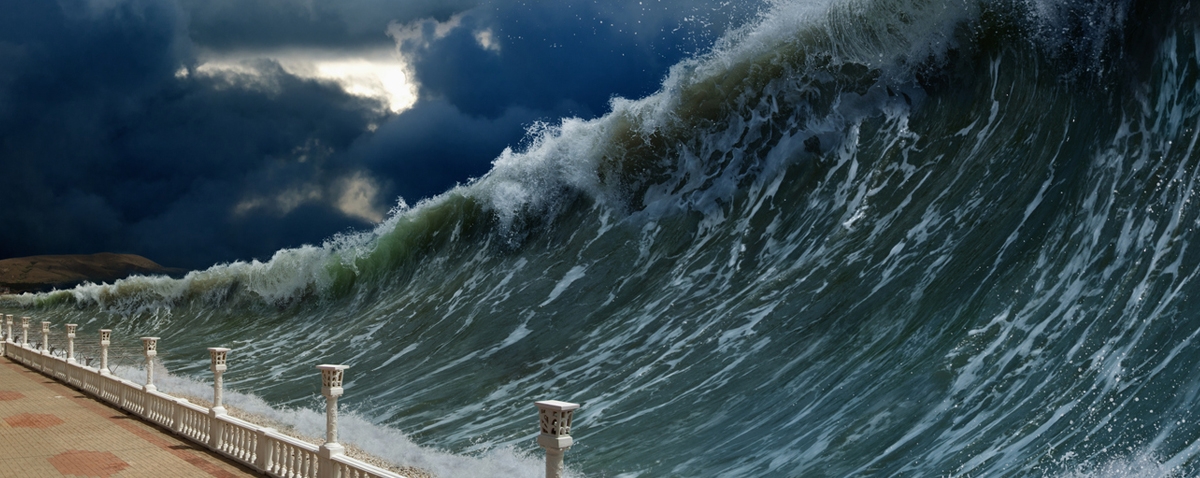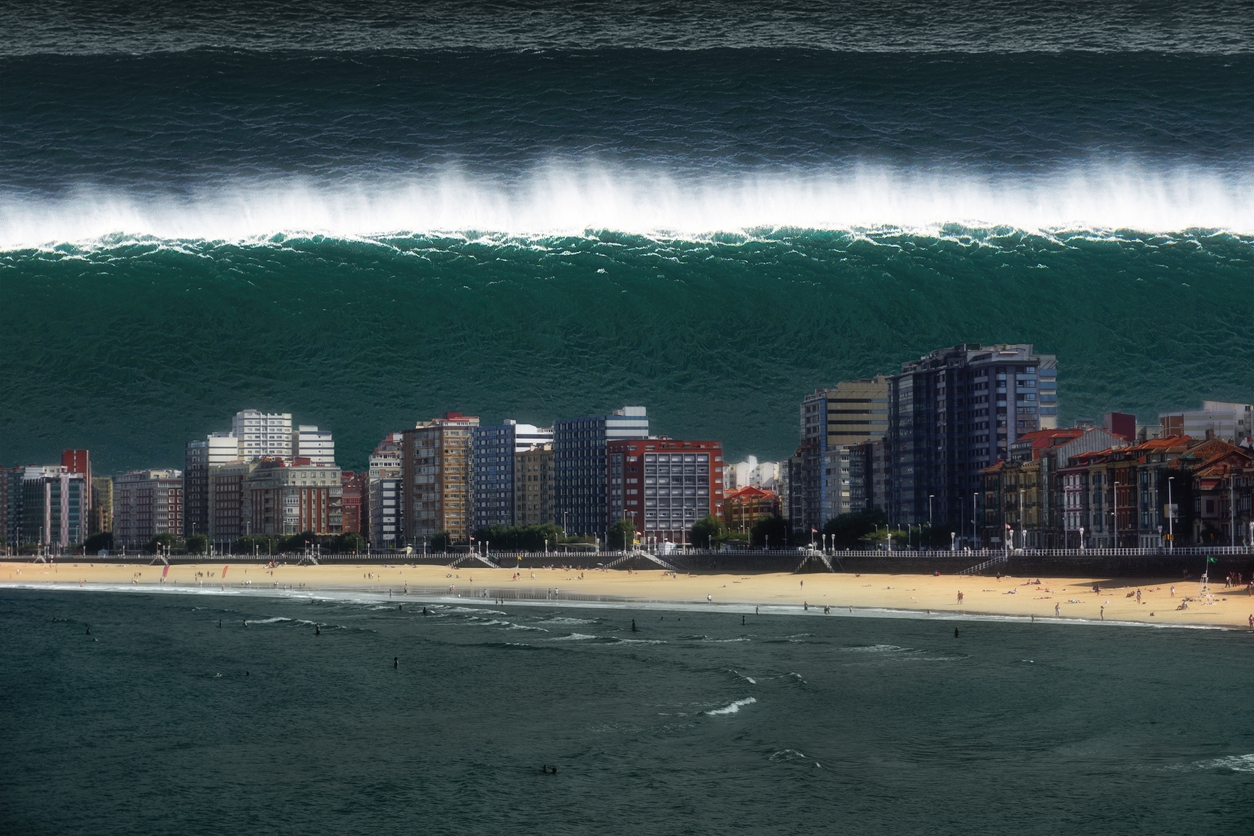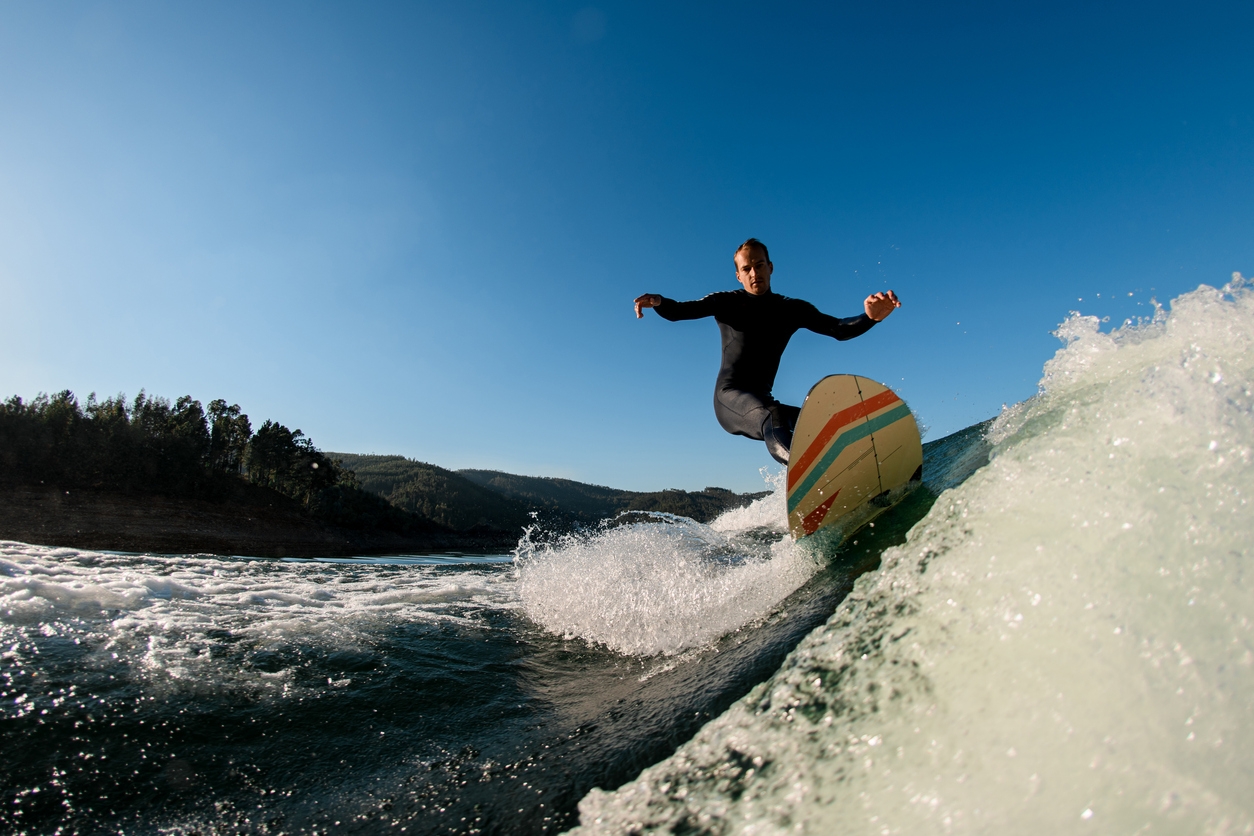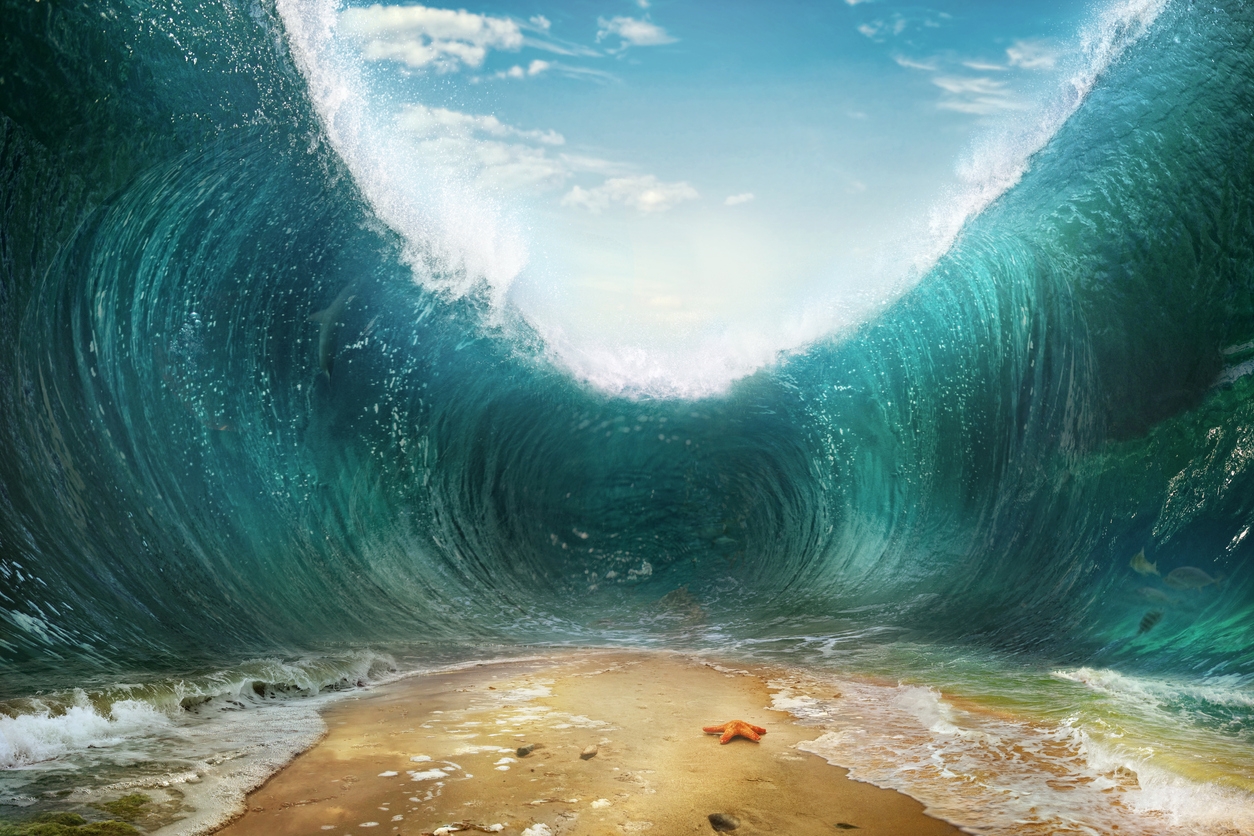Tsunamis make for some of the most powerful and destructive waves on earth. But could you ever successfully ride one? Surfing a tsunami isn’t something people undertake lightly, and there are countless risks to consider when tackling a wave of this magnitude. In this post, we’ll explore the odds of successfully surfing a tsunami in this article and answer some other burning questions you may have about the dangers and rewards of wave riding during these natural disasters.
Understanding Tsunamis
A tsunami is essentially a series of incredibly long and powerful waves caused by a significant disturbance at the ocean’s surface. This disturbance could be an earthquake, volcanic eruption, or landslide.
The initial wave is usually followed by several more equally powerful ones. [1] These waves can travel through an entire ocean basin and cause destruction along its shorelines. As the waves reach shallow water near coastlines, they begin to slow down but increase in height, creating some truly daunting waves for any surfer.
Characteristics of a Typical Tsunami Wave
| Characteristic | Description |
| Wave Height | Tsunami waves exhibit varying heights, ranging from mere centimeters for distant waves to several meters for those nearing the shore. |
| Wavelength | These waves possess notably extended wavelengths, often spanning hundreds of kilometers across open ocean waters. Their wavelength decreases as they move closer to the shore. |
| Speed | Tsunami waves race across the deep sea at remarkable velocities, reaching speeds of up to 700 to 800 kilometers per hour. |
| Energy | Tsunamis harness exceptional energy due to their vast size and incredible momentum, making them a force to be reckoned with. |
| Impact Force | As they approach shallow coastal waters, their energy concentrates, resulting in a colossal impact force that can inundate the shoreline. |
| Multiple Waves | Tsunamis commonly manifest as a series of waves, with later waves sometimes surpassing the initial wave’s size, causing unpredictable impacts. |
Tsunami waves typically have an incredible energy level and reach heights anywhere from a few centimeters to tens of meters. [2] The crest-to-trough ratio is much steeper compared to your typical beach breaker wave since the tsunami wave’s peak energy is concentrated at the very front of the wave. [3] Plus, tsunamis can quickly move between hundreds of kilometers per hour, making it difficult for even experienced surfers to react quickly enough to catch them.
Surfing as an Extreme Sport
Surfing has become increasingly popular over the years due to its thrilling nature that attracts adrenaline junkies across the world. Some surfers are known for attempting bigger and wilder stunts, such as catching massive waves on fragile-looking boards or being wheeled onto huge ones with jetski boats. All of this for that perfect shot for their Instagram accounts.
Would It Be Possible to Surf a Tsunami?
Many people who love to surf may one day find themselves wondering what it would be like to ride a tsunami. This is an exciting prospect, but unfortunately it is not possible to safely surf a tsunami. Because of the power and size of a tsunami wave, the odds of successfully surfing one are incredibly low.
| Factor | Consideration |
| Wave Height | Tsunami wave heights are immense, making them too dangerous for traditional surfing due to extreme heights. |
| Speed and Force | The high speeds and colossal force of tsunami waves pose insurmountable challenges for safe surfing. |
| Drawback and Turbulence | The drawback effect and powerful undertows make controlling a board impossible and increase risk significantly. |
| Wave Shape and Break | Tsunami waves lack the curling shape necessary for conventional surfing, making riding them virtually unfeasible. |
| Debris and Chaos | Tsunamis often carry debris, adding hazards to the already perilous endeavor of attempting to surf them. |
| Unpredictability | Tsunamis are unpredictable and can shift in size and intensity, making it impossible to gauge their behavior. |
| Safety and Ethics | Attempting to surf tsunamis poses extreme risks, jeopardizing the safety of individuals and rescue teams. |
| Respect for Nature | Tsunamis are natural disasters with potentially devastating consequences, underscoring the need to treat them with respect and caution. |
It is highly unlikely that any individual could successfully surf a tsunami. [4] The sheer power and unpredictability of these waves make them impossible for even the most experienced surfers to ride. Therefore, it is essential that individuals understand the risks associated with attempting such an endeavor before making any rash decisions.
Has Anyone Ever Successfully Surfed a Tsunami?
The answer to this question is not a resounding no. Although most stories about people who have tried to surf a tsunami tend to be rumors, there have apparently been a few surfers who survived being out in the water during a tsunami.
- Felipe Pomar, a big wave surfer from Peru, claims to have surfed a tsunami at Punta Hermosa, Peru, in 1974. [5] He asserts that the wave had a rideable face, allowing him to maneuver on it. If Pomar’s account is accurate, he could be one of the few surfers known to have successfully ridden a tsunami.
- Tom Gogola, a Devon, England surfer, encountered a tsunami while at an outer reef in Samoa. [6] He described the wave as rising dramatically, looking unrideable with its square shape. The water level dropped significantly, revealing the coral and sea creatures.
- Chris Nel, hailing from New Zealand, was also surfing in Samoa when the tsunami struck. [7] He noticed a sudden change in water behavior, becoming glassy yet turbulent. The force of the tsunami pulled them out to sea, and he was astounded to see the once-covered reef exposed like a dried riverbed.
To date, there have been no recorded attempts at wave-riding on an actual tsunami. This is largely due to their destructive power and unpredictability. Even experienced surfers would have difficulty surviving such conditions.
What is the Probability of Surviving While Surfing a Tsunami?
Given the sheer size and force of tsunamis, it is difficult to calculate an accurate risk-of-death ratio. However, all experts agree that, for surfers who attempt to ride tsunamis, the risk of death is extremely high. [8] It is important to remember that tsunamis are not just large waves, they are incredibly powerful walls of water, capable of wiping out entire towns and villages without warning.
Why Most Tsunamis Are Not Surfable
| Reason | Explanation |
| Wave Height | Tsunami waves can reach towering heights, making them too dangerous for conventional surfing. |
| Speed and Energy | Tsunamis travel at incredible speeds and pack immense energy, creating conditions too hazardous to navigate. |
| Wave Shape and Curl | Tsunami waves lack the curling shape needed for rideable surf, as they don’t form the classic breaking waves. |
| Force and Debris | Tsunami waves lack the curling shape needed for rideable surf, as they don’t form the classic breaking waves. |
| Unpredictable Behavior | Tsunamis are unpredictable, varying in size and behavior, making it impossible to anticipate wave patterns. |
| Turbulence and Drawback Effect | Powerful undertows and the drawback effect hinder control of the board and increase the risk of accidents. |
The Science Behind Successfully Surfing a Tsunami
Surfing a tsunami is an incredible feat, and is something that has actually not been attempted before. Surely, the success of such endeavors is not something that can be taken for granted.
The odds of actually succeeding in riding a tsunami are incredibly low. So, if you are considering attempting to surf a tsunami, it is important to be aware of the science behind riding one and understand the potential risks associated with doing so.
Understanding Wave Dynamics
When understanding the science behind surfing a tsunami, it is essential to first understand the dynamics of waves and how they behave.
| Behavior | Explanation |
| Motion | Ocean waves move in a characteristic up-and-down motion, transferring energy as they propagate across the water’s surface. |
| Energy | Waves carry energy from one place to another. The bigger the wave, the more energy it holds and can transfer across the ocean. |
| Interactions | Waves can interact with various elements such as coastlines, obstacles, and each other, causing changes in direction and shape. |
| Breaking | Waves break when they approach shallow waters, causing them to tip over and create the familiar surfable shape. |
| Wavelength | The distance between consecutive wave crests (or troughs) is the wavelength. Longer wavelengths can lead to faster wave speeds. |
Specifically, a wave moves through the ocean in an up-and-down motion and dissipates energy as it moves away from its source. This makes it possible for surfers to ride a wave and be propelled forward by its energy. Waves can bend, break, and be stunted by obstacles and boundaries in their path. It is these characteristics of wave behavior that makes it possible for someone to potentially ride a tsunami.
Wave Dynamics of a Tsunami
When attempting to ride a wave, a few key factors must be considered.
Height and Length
The most crucial consideration is its height and length. Tsunamis typically have much higher heights than ordinary waves due to their large energy source, which can cause them to become dangerous quickly. It is important to have an understanding of how high the wave is at its peak before attempting to ride it.
Length
The length of the wave should also be taken into consideration. Some tsunami waves may take longer than usual to traverse due to their greater energy source.
Directional Changes
Another factor that a surfer planning to ride a tsunami must take into account is its directional changes. A wave (tsunami or ordinary) can bend or break due to an array of oceanic obstacles and boundaries that it meets during its travel. These interactions can cause it to change direction suddenly.
Speed and Energy
The speed of a tsunami will also vary due to its energy source, making it more difficult for riding on top of it. The faster speed of a tsunami means that riders need to have quick reaction times or risk being taken off guard by sudden changes in direction or height of the wave.
Energy
The energy of a tsunami can also make it difficult to surf on top of it. The wave’s power can push riders off balance if they are not prepared for its force.
What If You Surf on a Tsunami?
Surfing a tsunami is an impossibility for most of us. If you have the know-how and gumption to take on this extraordinary challenge, it is possible, although highly unlikely, to succeed. It all comes down to what you’re willing to risk and how much preparation and planning you put in.
Let’s explore the potential dangers and challenges of attempting to surf a tsunami and consider the odds of successfully doing so.
Potential Challenges & Dangers
Attempting to surf a tsunami also comes with a lot of potential challenges and dangers.
For starters, chances are that you won’t be able to predict or control when and where the tsunami will hit land so you could end up stranded in open waters with no way back home without assistance from someone else.
Secondly, the undertow currents can be incredibly strong which means even if you manage to stay atop the wave, it could drag you under at any time without warning.
And finally, if your timing is off or if you misjudge the size or power of the wave, it could potentially result in serious injury or death.
Conclusion
Though it may not seem like it at first glance, there actually are some people who believe that it would be possible to surf a tsunami if all the proper precautions were taken into account beforehand. That being said, attempting to do anything this extreme comes with some serious risks which must be seriously considered beforehand. Ultimately, only those with vast knowledge of oceanic conditions and awareness should even attempt such a feat. And then only with extreme caution (if at all) due to its potential fatal outcome should something go wrong.
References
- 11 facts about tsunamis. (n.d.). DoSomething.org. https://www.dosomething.org/us/facts/11-facts-about-tsunamis
- Comparing tsunamis and surf. (n.d.). Science Learning Hub. https://www.sciencelearn.org.nz/resources/125-comparing-tsunamis-and-surf
- Tsunami & other wave types features. (n.d.). Earthquake & Tsunami Alerts to your cell phone. https://www.sms-tsunami-warning.com/pages/tsunami-features
- Why you can’t surf a tsunami. (n.d.). https://hilo.hawaii.edu/natural-hazards/tsunamis/surfing.php
- Gartside, L. (2021, August 16). Surfing through a tsunami in Peru; Felipe Pomar’s legendary ride. Wavelength Surf Magazine – since 1981. https://wavelengthmag.com/surfing-through-a-tsunami-in-peru-felipe-pomars-legendary-ride/
- Mirror.co.uk. (2012, January 28). Brit surfs the tsunami to safety. mirror. https://www.google.com/amp/s/www.mirror.co.uk/news/uk-news/brit-surfs-the-tsunami-to-safety-422331.amp
- Surfer survived Samoa tsunami by riding out the waves. (2009, October 2). the Guardian. https://www.google.com/amp/s/amp.theguardian.com/world/2009/oct/02/surfer-rode-samoa-tsunami-waves
- Gordon, H. (2023, June 11). Can you surf a tsunami wave? Exploring the possibilities and risks. The Surfing Handbook. https://www.surfinghandbook.com/can-you-surf-a-tsunami-wave/





